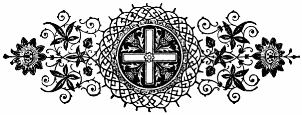
Saint Philip of Zell
|
During the reign of Charlemagne's father, King Pepin, there was living in the Rhenish palatinate, not far from the present city of Worms, a hermit named Philip who had an extraordinary reputation for sanctity and miracles. An Englishman by birth, he had settled in the Nahegau after he had made a pilgrimage to Rome, where he was ordained priest. Amongst those who sought out the recluse was King Pepin himself who, according to the legend, often visited him and conversed familiarly with him about holy things. The historian of St. Philip, who wrote a century after his death, states that through his intercourse with the hermit, Pepin "began to fear as well as to love God and to place all his hope in Him". As is so often the case with solitaires, Philip exercised a great attraction over the wild creatures of the forest: birds perched on his shoulder and ate from his hands, whilst hares frisked about him and licked his feet. He was joined in his solitude by another priest, Horskolf by name, who served God with him in prayer and helped to cultivate the land. One evening, thieves stole the two oxen which the hermits kept to aid them in their labours. All night long the miscreants wandered about the woods, unable to find their way out, and in the morning they discovered that they were back again in front of the hermitage. In dismay they threw themselves at St. Philip's feet, begging forgiveness. The holy man reassured them, entertained them as guests and sped them on their way. Gradually disciples gathered round the two hermits and a church was built.
A story is told that Horskolf, on his return from a journey, found Philip dead and lying in his coffin. With tears the disciple besought his master to give him the usual blessing which, for some reason, had been omitted when they had last parted. In reply the corpse sat up and said, "Go forth in peace, and may God prosper you abundantly in all things. Take care of this place as long as you live. Safe and sound you shall go forth; safe and sound shall you return." Then, having given the desired blessing, he sank back into death. Horskolf continued to reside in the hermitage until, at the age of 100, he passed away to rejoin his master. On the site of the cells was built a monastery, and then a collegiate church, in the midst of what became the parish of Zell, i.e. cell, named after St. Philip's hermitage.
The author of the life of St. Philip which is printed in the Acta Sanctorum, May, vol. i, is not known, but he was certainly not a contemporary, as has sometimes been stated. This text, with other materials, has been more critically edited by A. Hofmeister in the supplementary volume (Scriptores, vol. xxx, part 2, pp. 796-805) of Pertz, MGH. Some useful information concerning St. Philip and his cultus was printed in various numbers of Der Katholik of Mainz, inm 1887, 1896, 1898 and 1899.
Butler's Lives of The Saints, Herbert J. Thurston, S.J. and Donald Attwater
Nihil Obstat: PATRICIVS MORRIS, S.T.D., L.S.S., CENSOR DEPVTATVS.
Imprimatur: E. MORROGH BERNARD, VICARIVS GENERALIS
WESTMONASTERII: DIE XXIII FEBRVARII MCMLIII
|
|